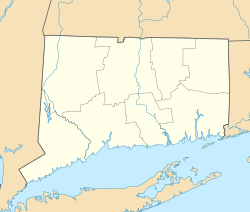Saxony Mill facts for kids
Quick facts for kids |
|
|
Saxony Mill
|
|

c. 1895 photo
|
|
| Location | 66 West St., Rockville, Connecticut |
|---|---|
| Area | 3 acres (1.2 ha) |
| Built | 1836 |
| Architectural style | Greek Revival |
| NRHP reference No. | 83003592 |
| Added to NRHP | November 10, 1983 |
The Saxony Mill was an old factory building in Rockville, Connecticut. It was built a long time ago, starting in 1836. This made it one of the oldest wooden textile mills in Connecticut. A textile mill is a place where cloth and fabric are made. Sadly, a fire in 1994 destroyed the mill, and it was later taken down. In 1983, the Saxony Mill was added to the National Register of Historic Places. This list recognizes important historical places in the United States.
Contents
About the Saxony Mill
The Saxony Mill was located in Rockville. It was at the western end of the town's industrial area. The mill used water power from the Hockanum River. Today, the land where the mill once stood is a public park.
Mill Buildings and Design
The mill complex had seven buildings connected together. Most of these buildings were made of brick and stone. They were built over many years, from 1836 until the 1970s.
The main building was the oldest part. It was made of wood and had two and a half stories. A special five-story bell tower rose from the middle of its front. Other buildings were added after 1870. These were built with strong, load-bearing walls.
History of the Mill
The oldest part of the mill was built in 1836. The Saxony Mill Company started in 1838. It was a company formed by the mill's owners.
At first, the mill made a type of fabric called satinet. This was a woolen material. It was created to be a cheaper choice than expensive wool fabrics. These expensive wools could only be bought from England at the time.
Over the years, the mill had different owners. They used the buildings for various steps in making textiles. Most of Rockville's mills closed in 1951. The main mill building was made bigger in 1861. More parts were added in the early 1900s.
The Fire and What Remains
Later, a company called Plastifoam used the mill. On July 25, 1994, a large fire happened. The building was empty at the time. The fire caused a lot of damage to the mill and nearby buildings. It also cut off power to many people. The damaged mill was taken down soon after the fire. Now, the area where the Saxony Mill once stood is a town park.



